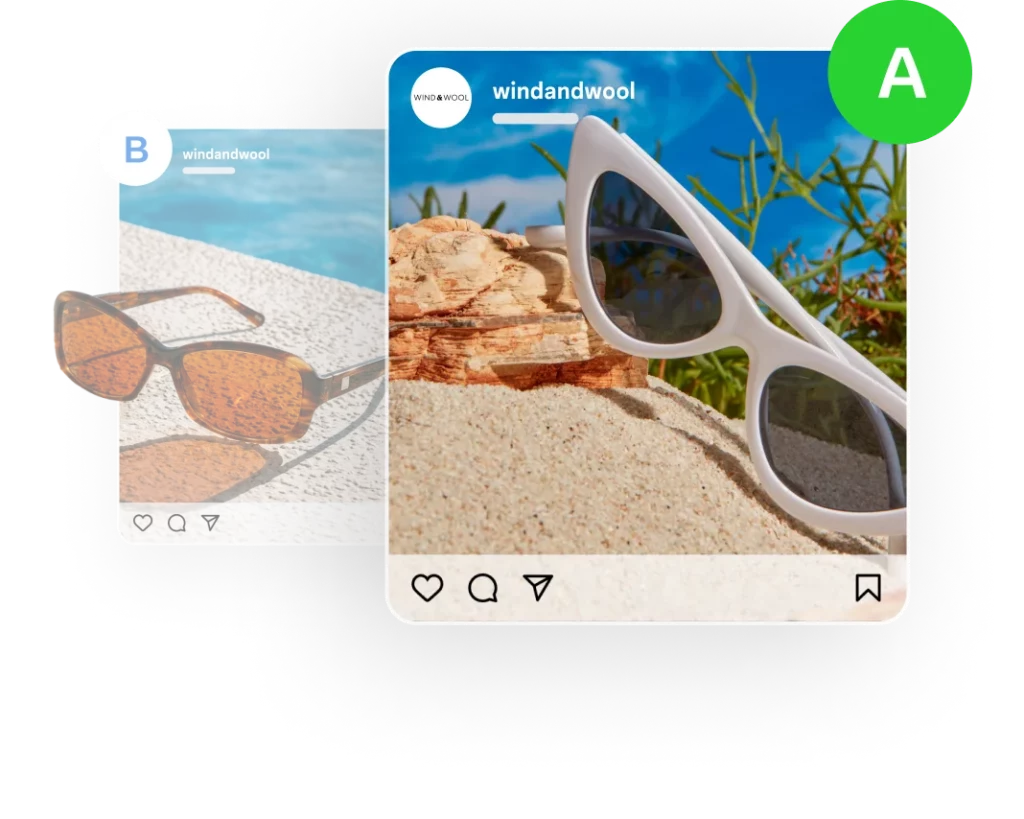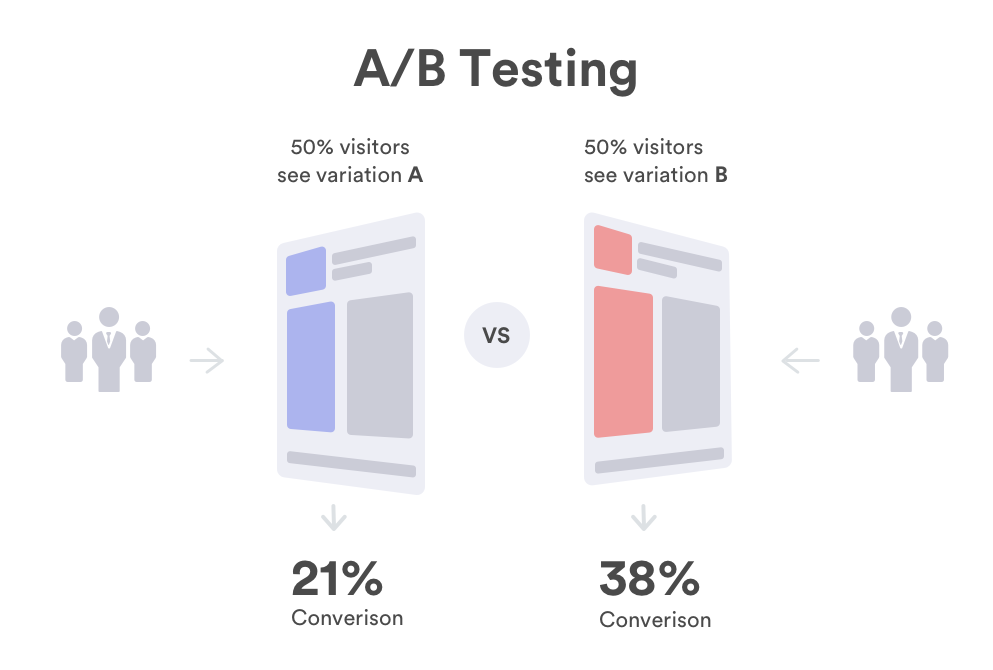Are you looking to maximize your Facebook Advertising ROI? If so, you’ve probably heard of A/B testing Facebook ads.
But have you dived into the world of testing your Facebook (Meta) ads yet? In this blog post, we’ll take you through the essentials of Facebook ads, and techniques that can dramatically boost your campaign performance.
A/B testing on Facebook (Meta)
First, let’s see what is A/B testing.
A/B testing, also known as split testing, is an experimental approach to assess the impact of different variables on predetermined key performance indicators (KPIs) like CTR, CR, and ROAS.
A/B testing is rooted in the scientific method, involving hypothesis formulation, experimentation, and data analysis. It aims to achieve statistical significance, indicating that the results are unlikely to have occurred by chance.
Benefits of testing Facebook Ads
First and foremost, A/B testing helps you increase conversion rates by identifying the most effective ad elements, such as headlines, images, and calls to action. By fine-tuning these components based on real data, you can create ads that resonate more deeply with your audience, leading to higher engagement and conversions.
Additionally, testing allows you to lower customer acquisition costs (CAC). When you know which ad variations perform best, you can allocate your budget more efficiently, focusing on the ads that yield the highest return.
This minimizes wasted spending and ensures that your investment delivers maximum value.
Moreover, A/B testing enhances the user experience by tailoring ads to meet audience preferences better. Ads that are more relevant and engaging naturally lead to a more positive interaction with your brand, increasing the likelihood of user engagement and long-term loyalty.
Finally, optimizing your ads through testing improves your overall return on investment (ROI). By consistently refining your campaigns based on performance data, you ensure that every dollar spent is driving your business goals.
In short, A/B testing is a powerful tool that helps you create more effective, cost-efficient, and user-friendly Facebook ad campaigns.
What elements can you A/B test?
When running A/B tests on Facebook ads, you can experiment with various elements to determine which versions are most effective.ou can experiment with elements across different levels of your campaign structure: Campaigns, Ad Sets, and Ads. Each level offers unique variables to test, helping you optimize your entire advertising strategy.
At the campaign level, your main focus is the overall objective and strategy of your advertising efforts.
The Ad Set level is where you define your audience, placement, and budget. Testing here can lead to insights about who sees your ads and where they perform best.
And, at the Ad level, you focus on the creative aspects of your ads—the visuals and copy that directly engage your audience.
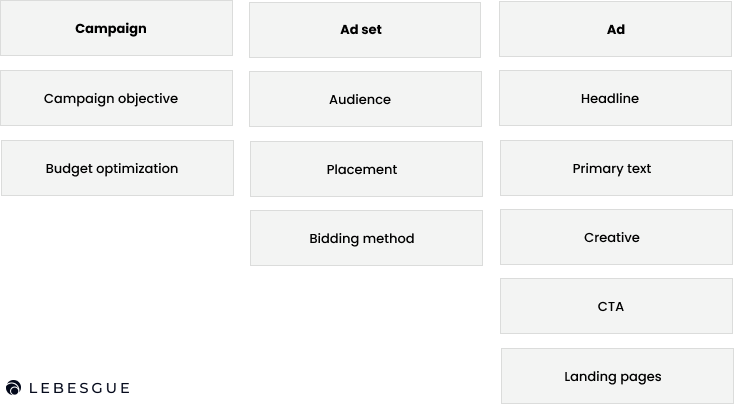
The elements you should prioritize in A/B testing are audience, landing pages, and images/videos.
Audience A/B testing
The first step in any A/B testing campaign should be audience segmentation. You can use different Facebook targeting options to A/B test what works the best, including:
- Lookalike audience
- Broad audience
- Interest-based audience
- Combining different age or gender groups
In our a/b test of Facebook audience for e-commerce businesses, the best performance we got was with broad targeting.
The results that we got with broad targeting was 113% better ROAS than with a Lookalike audience.
However, we recommend that you do an audience test and see what works best for your business.
A/B testing landing pages
The next step is your landing page.
After the customer clicks on your ad, the landing page is what he sees next. Focus on variables that are most likely to have a significant impact, such as A/B testing landing users on one of the:
- Product pages
- Collections pages
- Homepage
Different audience types, such as prospecting, retargeting, or video viewers, behave differently on different landing pages.
A/B testing creative type
And the last one A/B testing images and videos. When deciding whether to test images or videos in your Facebook ad campaigns, it’s important to consider the specific goals of your campaigns and your target audience.
Here’s a breakdown of what you can A/B test for image:
- Image content
- Colors and backgrounds
- Text overlays
- Image composition
- Image effects
If you have video ads, here on what you can focus on in your A/B testing:
- Video length
- Video content
- Call-to-action
- Narration vs. text
- Video thumbnail
- Video editings
- Video quality
- Background music or sound
What should you avoid in A/B testing?
While it’s tempting to test every detail, focus on macro variables that are more likely to impact your KPIs significantly. Avoid getting lost in the weeds with micro variables like font styles or button shades.
What you should be focusing on are macro variables:
- Images vs. Videos: Visuals are the first point of contact between your ad and your audience. Should you use an eye-catching image or a compelling video? This is a high-impact variable worth testing.
- Long Ad Description vs. Short Ad Description: Does your audience appreciate detailed information, or do they prefer quick, digestible content?
- User Benefits vs. Brand Story vs. Product Line: What drives your audience to engage? Is it how the product benefits them, the ethos of your brand, or the uniqueness of your product line?
Seasonality and A/B Testing
But, how does seasonality affect A/B testing? Well, external factors like seasonality or a site-wide sale can significantly skew your A/B testing data. Always account for these variables before drawing any conclusions. For example:
- Sales and Promotions: If there’s a site-wide sale happening, people might be more likely to convert, making your ad seem more effective than it usually would be.
- Seasonality: Holidays, seasons, and events can influence shopping behavior. Make sure you account for these in your A/B testing framework.
- Units availability: If you’re A/B testing images that showcase different products, and one is in stock, the other out of stock, it can significantly impact your A/B testing results
How to lunch A/B testing on Facebook?
How can you effectively run A/B tests on Facebook ads? The key is to focus on testing only one variable at a time. If you change multiple elements simultaneously, it becomes impossible to determine which change had the most significant impact on your results and by how much.
So, what’s the best way to test your ads? Let’s explore with an example.
You want to determine whether your return on ad spend (ROAS) improves more when you optimize your campaigns for sales versus traffic. To do this, you would create two separate campaigns—one with a sales objective and the other with a traffic objective.
All other elements must remain identical: the same call-to-action (CTA), visuals, audience targeting, budget, etc. The only difference between the campaigns should be the objective.
Once you’ve tested this variable, you can move on to other aspects of your campaign. For instance, if you want to test different audiences, ensure that the campaign objective stays consistent across both versions. This approach allows you to isolate the impact of each change, giving you clear insights into what drives the best performance.
Facebook Ads creative testing
With so many elements at play, it’s easy to get overwhelmed. Let’s break down the key components that you should be giving your attention to.
Audience segmentation: Who are your ideal customers?
Audience segmentation is often the first step in creative testing. Make sure you’re reaching people who are interested in what you’re offering by testing different demographics and behavioral traits.
Experiment with various demographics, psychographics, and behavioral segments to understand who is genuinely interested in your products.
Landing page: What happens after the click?
The moment a potential customer clicks your ad, they’re taken to your landing page. This is your opportunity to seal the deal.
Consider A/B testing your headlines, the Call to Action (CTA), and even the overall layout to optimize conversions. Remember, your landing page should be a continuation of the promise made in the ad.
Visuals: Are images or videos more engaging?
First impressions are crucial in creative testing. Are your potential customers more captivated by images or videos?
Visuals are often the first thing a user interacts with. Do they like video content more, or are they captivated by stunning imagery? Knowing the answer can drastically improve engagement rates.
Ad copy and headlines: How do you keep them reading?
The role of ad copy and headlines comes into play after the visuals have caught the user’s eye. What tone resonates with your audience? Should you keep it short and sweet or go into the nitty-gritty details?
Testing these aspects can significantly increase your CTR and conversion rates.
Call to action (CTA): What drives the final click?
You’d be surprised how minor changes in your CTA can lead to massive shifts in conversion rates. Test out different action verbs, button colors, and placements to pinpoint what really pushes your users to take action.
For an e-commerce merchant, some things are already predetermined and well A/B tested.
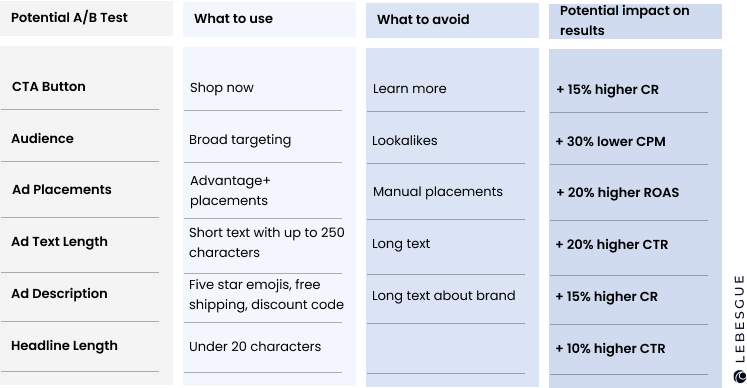
Creative testing mistakes
The most common mistakes that you can make while a/b testing your Facebook ads are testing too many variables at the same time, too long testing time, and ignoring the mobile users.
- Testing too many variables: Keep your creative tests simple and straightforward. Testing too many variables simultaneously can dilute the insights you gain. You won’t know which variable caused the observed change. Stick to one variable per test to keep your data crystal clear.
- Inconclusive Time Frames: How Long Should I Run My Test? Run your creative tests for a duration that’s long enough to get statistically significant results. Too short or too long can compromise your creative testing process.
- Ignoring Mobile Experience: Is Mobile Really That Important? With more people shopping on their phones, ignoring the mobile user experience can be detrimental. Make sure to test how your ads and landing pages perform across different devices.
Secret to A/B testing Facebook Ads
One of the most underrated strategies for setting up a successful test is knowing what’s working for your competitors.
With Lebesgue: AI CMO’s Competitor Intelligence feature, spying on your competitors’ Facebook ads has never been easier.
Use Competitor Intelligence to inform your A/B tests
The process is straightforward but powerful:
- Scan & Analyze: Use Lebesgue’s Competitor Intelligence to scan and analyze the Facebook ads your competitors are running. This includes ad creatives, headlines, CTAs, and even the landing pages they’re directing traffic to.
- Identify Best Practices: The tool will help you identify the best-performing ads based on various metrics like engagement rates, CTR, and conversion rates. Take note of common themes or practices that seem to resonate with your target audience.
- Formulate Your A/B Test: Armed with this data, create an A/B test where you pit your current best-performing ad against a new ad that incorporates these successful elements from your competitor’s campaigns.
- Adjust Your Variables: Whether it’s the visual elements, ad copy, or CTA, integrate the insights you’ve gathered into one of your ad sets. Remember, test only one variable at a time for the most accurate results.
- Run the Test: After setting up your ads, let them run for a statistically significant amount of time to gather actionable insights.
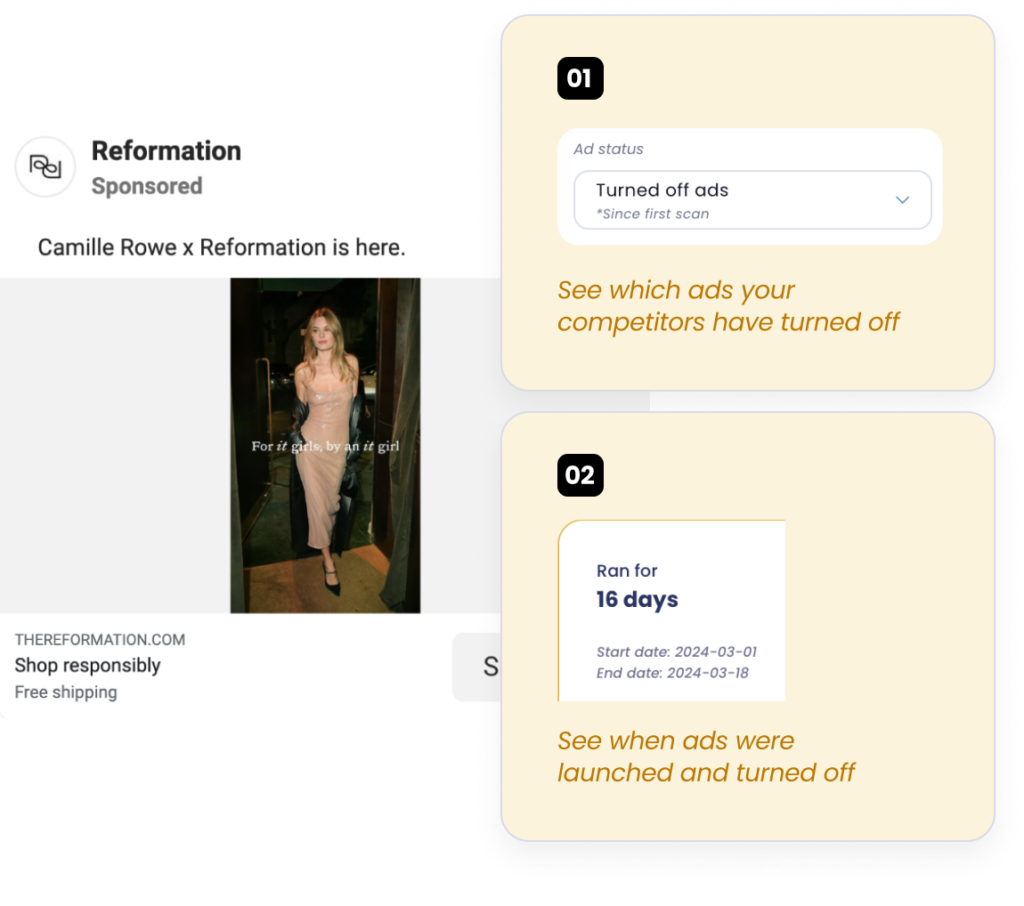
Your competitors have already done some of the legwork in figuring out what resonates with the audience you both share.
With the Competitor Intelligence feature, you’re making calculated decisions based on proven strategies.
Summing up
We hope this blog post gives you all the answers you had about A/B testing Facebook ads.
You can increase your advertising results when you know what works for your e-commerce and what does not.
So, if you give A/B testing a chance let us know the results!

